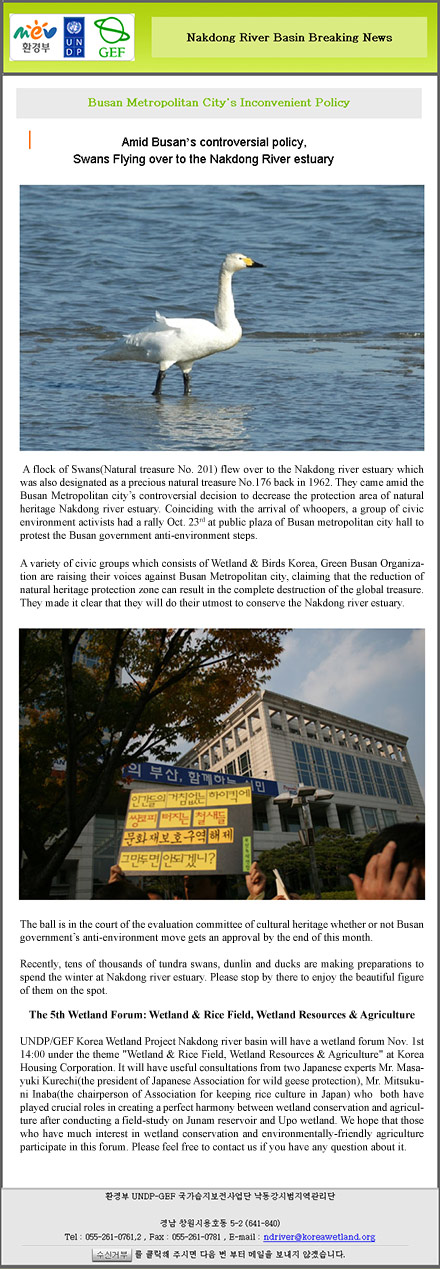The Nakdong Estuary has long been recognised as an internationally important wetland for waterbirds, matching multiple criteria for designation as a Ramsar site. It is a fairly large estuary, located in the mildest (unfrozen) southeast corner of the Korean peninsula, lying within the jurisdiction of Busan Metropolitan Government.
The estuary was formerly extremely important internationally for waterbirds, and probably close to 35 species of waterbird were supported by the system in internationally important numbers. It still remains very important, with ca 40,000 waterbirds at peak in winter, and a broad and diverse range of species still present in internationally important concentrations, including e.g. Whooper Swan (with Korea's largest concentration of ca 2000+), Taiga Bean Goose and Grey-tailed Tattler, with annual Spoon-billed Sandpiper (five in 2007) and Relict Gull.
In the late 1980s, an estuarine barrage was constructed (with World Bank money), and much of the dynamic nature of the system was diminished. The Nakdong River is Korea's largest, and although the tidal range is only 1.5 m on highest Spring tides, tidal influence used to reach tens of kilometere upstream. Now there is typically a sharp divide between fresh water (upstream of) and marine water (below the barrage). Connected to the construction of the barrage, there has been much conversion of upstream wetland and adjacent wetland, and also loss of significant areas of tidal-flat within the western expanses and along the eastern flank of the estuary - for agriculture, industry and housing. This kind of development in the estuary itself is against the conditions of the original World Bank loan (which requested the conservation of all remaining wetland areas) and has negative impacts on remaining areas, which are protected by a range of domestic conservation-driven legislation - including designation as a National Natural Monument (since the 1960s). More recently, certain areas have also been protected more strictly through designation as Wetlands Conservation Area under national ministry level jurisdiction. Recognising the value of the estuary, Busan City also initiated a major restoration project of a core part of it in 2000, and have recently opened a very large and expensive Eco-centre, on an area known as Ulseuk Island.
Although not (yet!) a Ramsar site, much of the Nakdong Estuary is about as strictly protected as it can be under national legislation, and it is clear that Busan City has also invested heavily in recognising and conserving the estuary's importance for wildlife and for people.
Despite all of this, there is a major, already half-finished, highway-bridge (the Miyeonji Bridge) being constructed right through the estuary, even right through the restored area (for an old link on the anticipated impacts of this and more background information on the estuary itself, please see: http://www.birdskorea.org//Habitats/Miscellaneous/BK-HA-Misc-Miyeongji-Road-Bridge.shtml), and in October 2007, Busan City have started to move to overturn designation of much of the western part of the estuary as a National Natural Monument.
Busan City cite the area's lack of value to biodiversity. This is unsurprisingly in direct contradiction of the findings a 2006 survey commissioned by the Ministry of Environment-UNDP-GEF Korea Wetlands project. Although the reasons for this proposed delisting have apparently not been made explicit, Birds Korea have been informed by well-placed sources that some people in the city hope to revive long-buried plans to construct a new airport on an artificial island within the estuary itself, in the same area now threatened with delisting.
Many environmental groups in Busan have now formed a protest coalition condemning the move to delist this part of the estuary as a National Natural Monument, holding a demonstration outside of the City Hall on October 23rd.
Birds Korea, especially as an organisation based in Busan, also believes we need to use this ongoing and heated debate as an opportunity to gather and deliver good information and opinion, to raise awareness of the values and benefits of conservation of the estuary through strategic and well-focused advocacy. We are therefore re-gathering data on the international importance of the estuary - and intend to present a document to the city containing scientific, legal and economic arguments for the conservation of the whole of the Nakdong Estuary, with an aim of winning eventual designation of the whole estuary as a Ramsar site. We welcome the support and input from our members, both national and international, to help in this long and important process.
Birds Korea, October 24, 2007.




